Olympus iS-3 DLX User Manual

INSTRUCTIONS
Before using your IS-3DLX, read this manual carefully to ensure correct use.
We recommend that you take test shots to get accustomed to your IS-3DLX before taking important photographs.
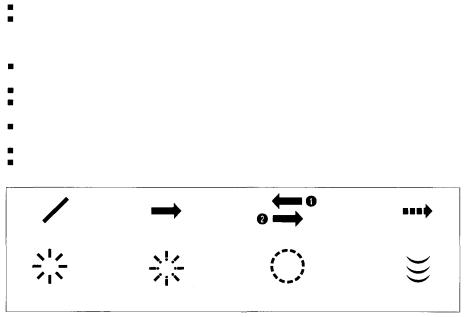
Thank you for purchasing the Olympus IS-3DLX.
MAIN FEATURES
Built-in 35mm ~ 180mm approx. 5X zoom lens for increased shooting range.
Powerful built-in, dual-element intelligent flash system rated at GN 28 (ISO100·m)/GN 92 (ISO100·ft),fortelephoto and GN 20 (ISO100·m)/GN 66 (ISO100·ft), forwide angle, corresponding to distant subjects and zoom shooting with high magnification and assuring beautiful pictures.
ED (extraordinary dispersion) glass is used in the lens, achieving crisp, clear images with high contrast.
The standard shooting mode lets anyone take beautiful pictures easily. Panorama photographs are possible when the optional panorama adapter is attached.
Other various easy-to-use functions include versatile flash, subject, drive, and exposure modes and more.
Optional remote control for Bulb shooting, etc. Date imprinting function.
Symbols used in this manual:
Incorrect |
Manual |
Operation |
Automatic |
|
operation |
order |
operation |
Indicator on |
Indicator |
Attention |
Depress |
2 |
blinking |
|
halfway |
|
|
|

PREPARATIONS
Names and functions of parts ......... |
4 |
Viewfinder display/LCD panel ......... |
6 |
Attachingthestrap........................ |
7 |
Outline of operations ................ |
8 |
Loading the batteries ...................... |
10 |
Checking the batteries................ |
11 |
Points to remember .................... |
12 |
Reset operation ............................. |
14 |
|
Loadingthefilm ...................................................................................................... |
15 |
BASIC OPERATIONS |
Taking pictures ............................................................................. |
18 |
|
Unloadingthefilm..................................................................................... |
21 |
ADDITIONAL FUNCTIONS
TAKING BETTER PICTURES
CAMERA MAINTENANCE
Using the focus lock ................ |
22 |
Flash photography .................... |
23 |
Selftimer ........................... |
30 |
Macro photography .................... |
32 |
Using the exposure modes ............ |
34 |
Flash photography in the manual |
|
exposuremode............................ |
45 |
Exposure compensation..................... |
46 |
Flash .................................... |
63 |
Electronic flash G40 (optional) ......... |
65 |
Effectsofzoomanditsadvantages .. |
68 |
Autofocus (AF) .................................. |
70 |
Exposure ....................................... |
72 |
Metering the amount of light ............. |
74 |
Using the drive modes .................... |
47 |
Power focus .......................................... |
52 |
Spot metering ................................. |
53 |
Zoomexposure ............................ |
54 |
Autofocus beep ................................... |
55 |
Remotecontrol(optional) ............... |
56 |
Printingthedateandtime ................. |
61 |
Correcting the data ...................... |
62 |
Exposure compensation.................. |
75 |
Film speed............................................... |
75 |
Macro photography............................... |
76 |
Panorama photography..................... |
77 |
Accessories (optional)........................... |
78 |
Care and storage ........................................................................... |
79 |
Battery handling ............................................................................................... |
80 |
Troubleshooting ....................................................................................... |
81 |
Questions and answers .................................................................................... |
84 |
Specifications .............................................................................................. |
85 |
3
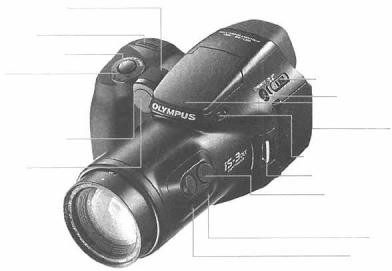
PREPARATIONS
NAMES AND FUNCTIONS OF PARTS
Remote control sensor
(rear)
Hot shoe cover
Shutter release button
Shift dial
Selects the flash, exposure and drive modes. (The same operation can also be performed with the shift buttons in the rear.)
Selects the shutter speed.
Remote control sensor (front)
AF illuminator
Also blinks when the selftimer is activated.
Power ON/OFF switch
Selftimer/remote
control button
Flash
Flash release (See p. 23.)
Strap attachment stud
Zoom (T/W) buttons
(See p. 18.)
Become the focus buttons in the PF mode.
PF button
Macro button
4

Viewfinder
(See p. 6.)
Exposure mode button
+/- button
Drive mode button
Flash mode button
DateMODE,SETand ADJUST buttons
Battery compartment cover
Spot button (See p. 53.)
Film window
For confirmation of film ISO speed
Back cover release
Mid-roll rewind button
Tripod socket
Shift buttons
Select the flash, exposure and drive modes.
(The same operation can also be performed using the shift dial in the front)
Select the aperture setting.
5
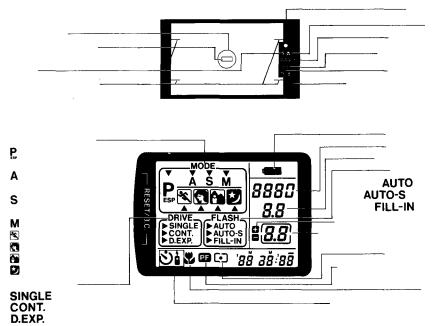
VIEWFINDER DISPLAY/LCD PANEL
VIEWFINDER DISPLAY
Spot frame
Autofocus frame
Flash
Panorama marks*
*Optional IS/L PANORAMA ADAPTER is required
LCD PANEL
Exposure modes:
Program auto-exposure/
ESP light metering
Aperture-preferred auto-exposure
Shutter-speed-preferred auto-exposure
Manual exposure Sports
Portrait
Landscape
Night scene
Drive modes:
Single-frame advance
Continuous-frameadvance
Double exposure
Autofocus Macro Shutter speed
Aperture setting Spot metering
Exposure compensation/ Manual exposure
Battery check Shutter speed Aperture setting
Flash modes:
Auto flash
Auto-S flash Fill-in flash
Exposure compensation Exposure counter/Exposure compensation level Spot metering Power focus (autofocus override)
•Macro Selftimer/Remote control
6

ATTACHING THE STRAP
7
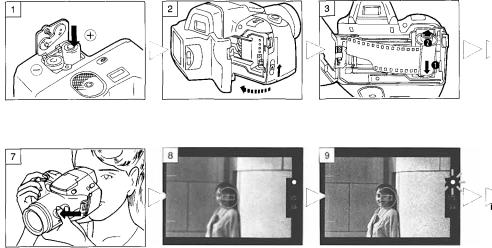
OUTLINE OF OPERATIONS
Basic Shooting Procedures
Load the batteries (p. 10). |
Open the back cover (p. 15). |
Load the film (p. 15). |
Press the zoom buttons to determine the composition (p. 18).
Place the autofocus frame on the subject you want to focus on (p. 19).
Depress the shutter release button halfway, making sure the autofocus indicator in the viewfinder lights and the autofocus beep is heard (p. 20).
8
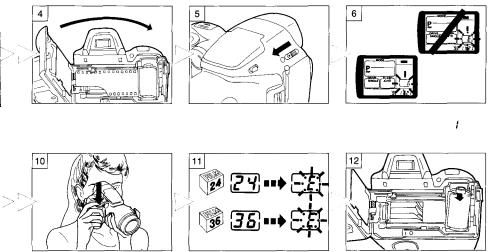
Close the back cover (p. 17). |
Turn the power switch ON |
|
(p. 17). |
Depress the shutter release |
When the film reaches the end, it |
button fully to take a picture |
will automatically rewind (p. 21). |
(p. 20). |
|
Make sure the exposure counter on the LCD panel reads " " (p.17).
Open the back cover to remove the rewound film (p. 21).
9
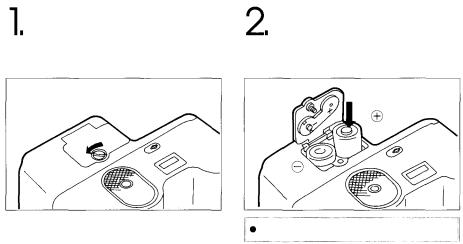
LOADINGTHEBATTERIES
Use two 3V lithium batteries (CR123A or DL123A).
Turn the lock screw on the bottom of the camera counterclockwise to open the battery cover.
Insert the batteries as shown and replace the cover, turning the lock screw clockwise.
 The types of batteries that can be used are also shown inside the battery cover.
The types of batteries that can be used are also shown inside the battery cover.
 When replacing the batteries, make sure to turn the power switch OFF before unloading the batteries.
When replacing the batteries, make sure to turn the power switch OFF before unloading the batteries.
Read "Battery Handling" on page 80.
10
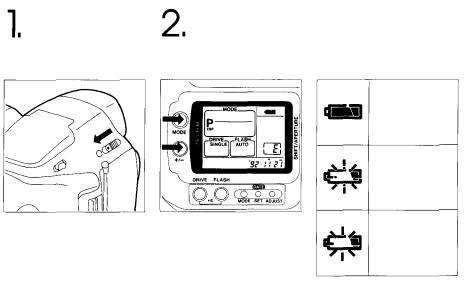
CHECKINGTHEBATTERIES
Turn the power switch ON.
Press the exposure mode and +/-
buttons simultaneously to check the batteries.
Blinks
Lights
Batteries are OK. The mark disappears when the finger is released from the button.
Batteries are low.
Have spares handy.
Batteries should be replaced immediately.
11
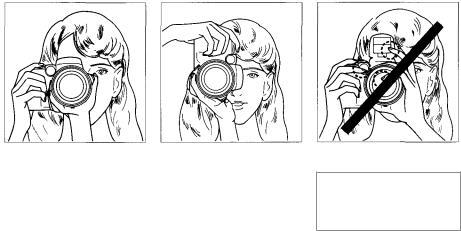
POINTS TO REMEMBER
Hold the Camera Correctly.
Correct. Correct.
Note: As the focal length becomes larger, shaking the camera becomes more noticeable. Hold the camera firmly with both hands while keeping elbows at sides to prevent the camera from shaking.
Incorrect.
Caution:
Keep your fingers away from the lens, AF illuminator and flash.
12
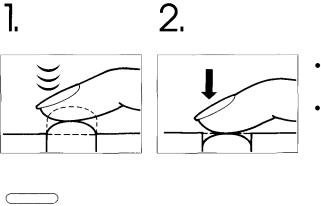
Proper Shutter Release. Practice before loading the film.
Keep the shutter |
Depress the |
|
|
release button |
shutter release |
|
|
Cautions: |
|||
depressed halfway. |
button fully. |
||
|
|
Press the shutter release |
|
|
|
button gently. |
|
|
|
Avoid shaking the |
|
|
|
camera when pressing |
|
|
|
the shutter release button |
|
|
|
to prevent blurry pictures. |
|
|
|
|
To lock the focus.
Make sure
The image is clear, the autofocus beep is heard, and the autofocus indicator lights in the viewfinder.
To release the shutter and take the picture.
Note: When the autofocus indicator doesn't light, the shutter won't release.
(See p. 70.)
13

RESET OPERATION
Reset operation restores the standard shooting mode, for worry-free photography that anyone can perform. Also use this mode when you don't know what operation to perform.
Press the exposure mode and +/- buttons simultaneously.
The camera will return to the standard shooting mode, and other set modes will be canceled.
Standard Shooting Mode
Exposure mode: Program Auto
(P)
Drive mode: Single (S)* Lightmeteringmode:ESP
Flash mode: AUTO or AUTO-S
Exposure compensation: ±0
Focusing:AF
Autofocus beep: On
*This mode won't be restored by performing the reset operation once the Double Exposure mode is activated and the first shot is taken. (See p. 50.)
14
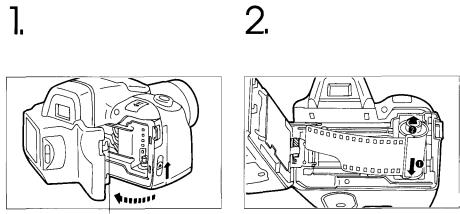
LOADING THE FILM
Slide the back cover |
Push in the film cartridge |
release upward to open |
until it clicks. |
the back cover. |
|
Shutter curtains |
Note: Use DX-coded film. |
|
Caution: Do not touch the shutter |
|
curtain, and do not press it with the |
|
edge of film. |
OPERATIONS BASIC
15
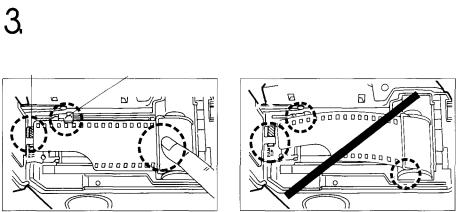
Pass the edge of the film under the film guide, and align the film leader with the film loading indicator.
Film loading indicator |
Film guide |
Note: Make sure the film is lying flat. If not, push the cartridge down.
16
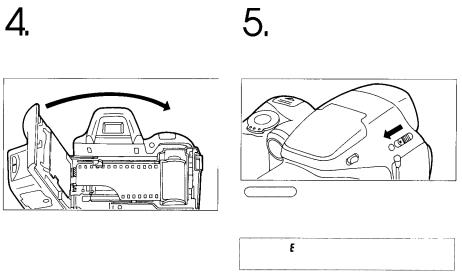
Close the back cover. |
Turn the power switch |
|
ON. |
The film automatically advances to the first frame.
Make sure
The exposure counter on the LCD panel reads  .
.
Note: If  blinks in the exposure counter, reload the film.
blinks in the exposure counter, reload the film.
17
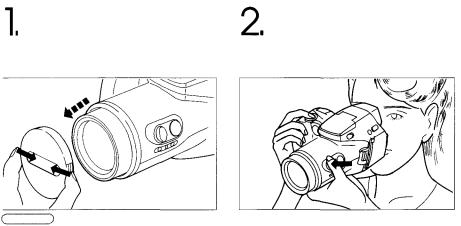
TAKING PICTURES
Follow the procedure here to cover ordinary photography.
Remove the lens cap, |
While looking through the |
and turn the power |
viewfinder, press the zoom |
switch ON. |
button to determine the |
|
composition. |
Make sure The lens advances, and the LCD panel lights.
Note: If no operation is made for approx. 30 seconds, the LCD panel goes out and will come on again when the operation is resumed.
There are two zoom speeds. Press the zoom button halfway for slow zooming and fully for fast zooming.
18
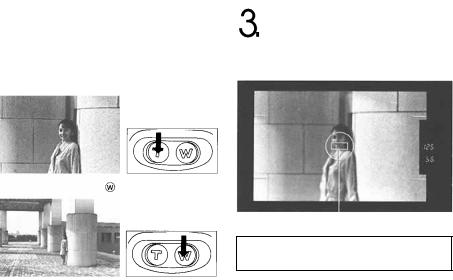
How to Use the Zoom |
Position the autofocus |
Buttons |
frame on your subject. |
Telephoto: Press the  button to zoom in.
button to zoom in.
Max. telephoto focal length: 180mm
Wide-angle: Press the  button to zoom out.
button to zoom out.
Max. wide-angle focal
length: 35 mm
Autofocus frame
Working distance 1 2 m (3 9 ft) ~
19

Depress the shutter |
Depress the shutter release |
release button halfway. |
button fully to take the picture. |
Make sure The autofocus beep is heard and the autofocus indicator lights when the subject is in focus.
It will blink if the subject is difficult for the autofocus to lock on, and when the subject is too close.
Note: When the autofocus indicator blinks, the shutter won't release. (See p. 70.)
The shutter releases and the film
automatically advances to the next frame.
20
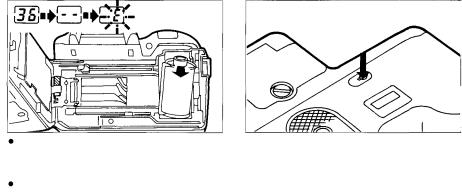
UNLOADING THE FILM
The camera automatically rewinds the film when you
reach the end of a roll.
Make sure the motor has stopped and the E is blinking on the LCD panel, before opening the back cover and removing the film.
Rewinding the film before the end of the roll
If the power is turned OFF while rewinding, operations will stop. Rewind mode, however, is not canceled. Rewinding will continue when the power switch is turned ON again.
The final number of exposures may sometimes exceed the number of exposures specified on the film.
After confirming that the power is ON, press the mid-roll rewind button with the tip of a ballpoint pen, or the like. Do not use an instrument with a sharp tip.
21

ADDITIONAL FUNCTIONS
USINGTHE FOCUS LOCK
When the main subject is not in the center of the Autofocus
frame, use the focus lock.
Position the autofocus frame on your subject and press the shutter release button halfway.
Reposition your subjects in the picture frame while keeping the shutter release button depressed halfway. Then press the shutter release button fully.
Make sure |
Autofocus frame |
Note: |
The autofocus beep is heard, and the |
When the focus is locked, the |
|
autofocus indicator lights in the |
exposure is also locked (AE lock). |
|
viewfinder. |
|
|
22
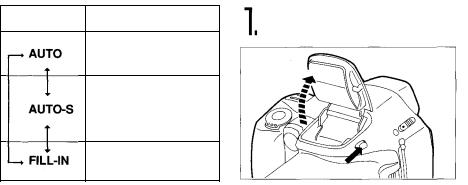
FLASH PHOTOGRAPHY
This camera has two flash tubes that are automatically selected and fired according to the shooting conditions. There are also various flash modes that can be selected to match your needs.
Flash Modes |
How to Select the Flash Mode |
Mode |
Function |
Automatically fires in low-light conditions.
(p. 26)
Significantly reduces the phenomenon of
"red-eye" (when a subject's eyes appear red). (p. 28)
Fires regardless of available light. (p. 29)
Note: See p. 45 for flash photography in the Manual
Exposure mode.
Slide the flash release to flip up the flash.
23
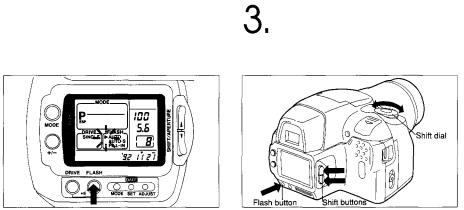
 Press the flash button.
Press the flash button.
While pressing the flash button, select the mode using the shift buttons or shift dial,
The available modes appear, and blinks on the left of the mode currently engaged.
blinks on the left of the mode currently engaged.
24
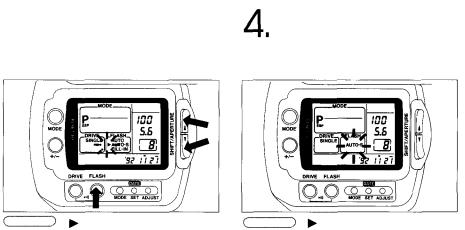
Release the flash button to engage the mode.
Make sure |
is blinking on the left of |
Make sure |
disappears, and the |
the selected flash mode. |
engaged flash mode remains on the |
||
|
|
LCD panel. |
|
25
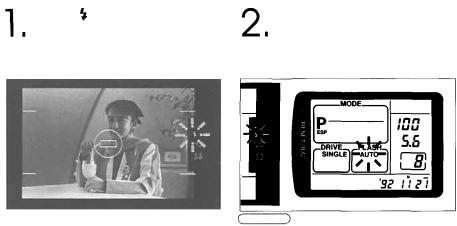
Auto Flash AUTO
The flash fires automatically when there is insufficient light.
When blinks in the |
When the flash is |
viewfinder, the flash |
flipped up, the camera |
should be used. Slide |
will start recharging the |
the flash release. |
flash. |
Make sure AUTO lights on the LCD panel. When the flash is recharged,  in the viewfinder will light.
in the viewfinder will light.
Note: The flash won't fire until recharging is finished.
26
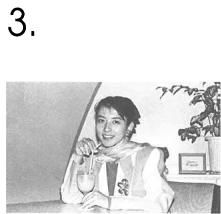
Press the shutter release button.
Auto Flash Range*
(with color negative film)
Focal length |
35mm |
|
|
180mm |
|
|
|
|
|
|
|
ISO 100 |
6.3 |
m |
(20.7 |
ft) |
7 m (23 ft) |
|
|
|
|
|
|
ISO 200 |
8.9 |
m |
(29.2 |
ft) |
9.8m (32.2ft) |
|
|
|
|
||
ISO 400 |
12.6m (41. 3 |
ft) |
14 m (45.9 ft) |
||
|
|
|
|
|
|
* The Auto Flash mode can be combined with the Macro mode.
Note: The shutter speed is automatically set at 1/100-sec. when the flash fires. If the subject requires a faster shutter speed, the flash won't fire.
27
